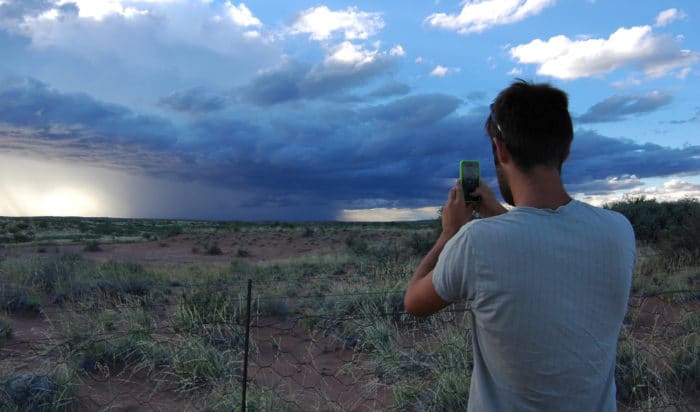Why We Love It
-
$90,210Potential Avg. Salary
-
9.3%Job Growth Rate
-
Growing DemandJob Outlook
-
Fast Paced CareerCareer Attribute
A storm chaser conducts meteorological research on the field, to report tornados, storms, hurricanes and other high-impact weather conditions to weather bureaus. This information is vital for accurate weather forecasting and warnings.
Recommended Schools
What is a Storm Chaser?
Duties
Here are the duties you can expect to perform in the storm chaser profession:
- Collect or analyse valuable research and information about extreme weather patterns for better advanced warnings to prevent casualties.
- Collaborate with a team and use specialised meteorological testing equipment to take readings and data.
- Monitor weather reports for expected severe conditions in particular areas in a region.
- Take close-up photographs and videos of severe weather with the intent of sharing and selling them with various media agencies.
- Write articles on storm activity, with details such as the severity and direction of a storm from the ground.
Day In The Life
When you take on this fast paced career, you will spend a lot of time traveling the country in search of storms and reporting significant weather activity to appropriate authorities. To survive extreme tornadoes and storms, you need to plan carefully and do your research for the right coverage. Depending on whether it is your hobby or part-time work, you will also take on valuable research to gain specialised knowledge about storm behaviour and detection.
You will coordinate with a team to operate meteorological equipment and accurately track down storms or the worst nature can throw. Part of the work will require keeping up with the latest trends in the industry and investing in forecasting tools (i.e. radar scans, satellite imagery), equipment and travel as needed. Having a second job to supplement their work
Work Schedule And Typical Hours
There are no fixed working hours due to the unpredictability of weather patterns. When you find a report on impending storms, you are expected to reach the scene and take careful notes to share with the local weather station. It is important to note that there are real risks to working as a storm chaser and getting close to storms must only be done with professional expertise, not amateurish enthusiasm. Usually, you will take a team instead of going alone to severe weather areas.
Growth Of The Job
As violent weather occurrences become more frequent, storm chaser roles have great potential. In this job sector, the expected growth rate is relatively standard since 2004. However, employment opportunities in the market have increased to 22.21% across the country, with a growth rate of 3.7% per year. By 2018, demand for those working in the atmospheric or space scientist industry will bring in 2160 new jobs. To advance in this field, you can find field work as a climatologist, meteorologist, scientific researcher and climate journalist.
Typical Employers
You could find work with employers that are interested in keeping the public secure, like Severe Storms Laboratory, National Weather Center, Storm Prediction Center, The Weather Channel, AccuWeather, etc. There are also reputable touring companies that offer others to witness storms and tornados alongside storm chasing professionals, such as Storm Chasing Adventure Tours, Cloud 9 Tours, Silver Lining Tours and Tempest Tours. While it might take you time to find paid opportunities and you may need to be self-employed, the work is highly rewarding on the adventure quotient.
Recommended Schools
How To Become a Storm Chaser
There are several ways via which you can enter the storm chaser profession. Many often start out with a hobby, as an assistant to a meteorologist or experienced storm chaser. Since severe weather occurrences are irregular, individuals in this career path take on other jobs and spend some months in a year chasing or documenting storm patterns.
You could also branch out as a storm chaser upon completing your education as a meteorologist, with at least an undergraduate degree from a college or university. While working on related research projects or at a weather firm, you can pursue your interest in the field and gain practice with storm chasing since it can often be dangerous.
If you genuinely crave excitement and the thrill of extreme weather, you will find that the work of a storm chaser is a great fit. Being passionate or curious about weather patterns and strong natural events like thunderstorms, tidal waves or hurricanes is a given. Superb driving skills and a calm demeanour can also serve you well in panicked situations with nervous locals and dangerous roads or terrain.
Storm Chaser Salary Data
We’ve provided you the following to learn more about this career. The salary and growth data on this page comes from recently published Bureau of Labor Statistics data while the recommendations and editorial content are based on our research.
National Anual Salary
Low Range
$66,200Average
$90,210High Range
$132,180National Hourly Wage
Low Range
$32/hrAverage
$43/hrHigh Range
$64/hrHow do Storm Chaser salaries stack up to other jobs across the country? Based on the latest jobs data nationwide, Storm Chaser's can make an average annual salary of $90,210, or $43 per hour. On the lower end, they can make $66,200 or $32 per hour, perhaps when just starting out or based on the state you live in.
Salary Rankings And Facts
#95 Nationally for All Careers
Above Average Salary Nationally
Programs and Degrees
Here are the most common degrees for becoming a Storm Chaser. a is usually recommended and specifically a degree or coursework that prepares you for the particular field, see below.
Highest Education Among Storm Chasers
- 11.1% Doctorate
- 24.7% Masters
- 44.7% Bachelors
- 9.2% Associates
- 10.2% College
- 0% High School
- 0% Less than High School
Job Growth Projections and Forecast
2014 Total Jobs
11,8002024 Est. Jobs
12,900Job Growth Rate
9.3%Est. New Jobs
1,100How does Storm Chaser job growth stack up to other jobs across the country? By 2024, there will be a change of 1,100 jobs for a total of 12,900 people employed in the career nationwide. This is a 9.3% change in growth over the next ten years, giving the career a growth rate nationwide of Above Average.
Growth Rankings And Facts
#225 Nationally for All Careers
Above Avg. Growth Nationally
What Companies Employ The Most Storm Chasers
| Industry | Current Jobs | New Jobs Needed | % Increase |
|---|---|---|---|
| Federal government, excluding postal service | 3,100 | -300 | 0% |
| Research and development in the physical, engineering, and life sciences | 2,500 | 100 | 0% |
| Television broadcasting | 700 | --- | 0% |













